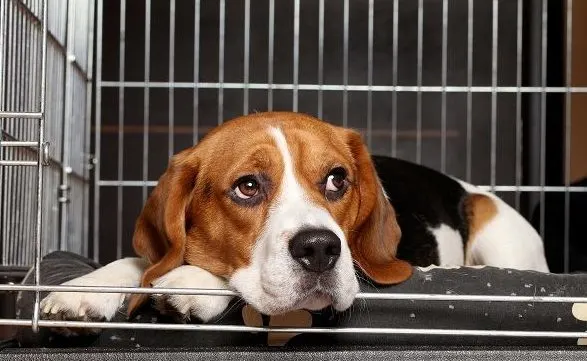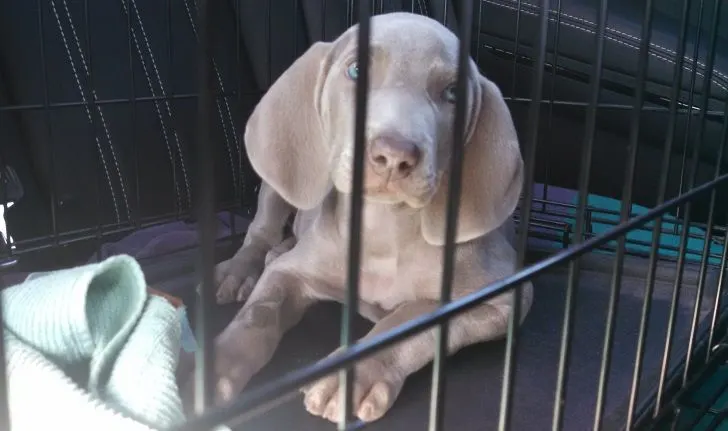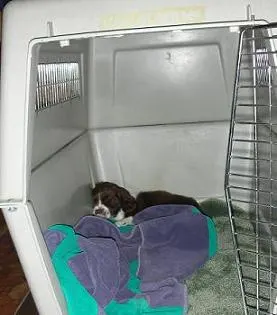Crate training a puppy is the process of teaching him to recognize a box as a heaven. It’s generally recommended by breeders, rescues, trainers and vets.
If you recently adopted a puppy, start crate training when the puppy is still young.
With my own dog, crate training reduced his separation anxiety. Some dogs suffer from separation anxiety when they move to new surroundings. Stress causes the dog to misbehave, such as eating your furniture or favorite shoes! Such a disaster, right?
By following my instructions below, crate training will restore order in your home within 4 to 6 days at most.

This is the general guide I used for my own dog. It won’t necessarily be the best method for all dogs. Please share your own crate training tips or questions in the comments. I’m using “crate training” interchangeably with “kennel training.”
How to crate train your puppy
Training needs to be gradual, following a sequence of small, easy steps.
1. Introduce your puppy to the crate.
I placed my puppy Bently’s crate in open view and encouraged him to explore by putting a few dog biscuits in the crate. Puppies are naturally drawn to food or items they can bite on.
If the dog hesitates to reach for the snack, bring him to the crate and encourage him in a friendly tone. Place dog toys in the crate to encourage regular visits. This really worked with my buddy after half a day, although he did hesitate at first.
2. Feeding your puppy in the crate – turn the crate into ‘a restaurant.’
Once the puppy or dog starts associating the crate with snacks, it’s time for a bigger step. Make your dog’s feeding area at the front of the crate, then at the entrance, and finally, inside the crate. Remember to observe the reactions of the dog and adjust as necessary.
For instance, if the dog hesitates to eat food placed at the entrance of the crate, consider putting the food outside and revisit the doorway position after a few days. Repeat this process until the puppy is fully comfortable eating inside the crate.
To share with you guys, it took my Bently a couple of meals to get used to eating in his crate. Every time I moved his food further into the crate he decided to bark and not eat! (This is his personality.)
If you encounter the same situation, be patient and move the food little by little so your puppy doesn’t even realize the change.
Once the puppy is used to eating inside the crate, move the bowl further and further towards the back. Eventually, the puppy will accept the crate as his place to eat.

3. Crating your puppy for longer.
At this point, the dog has all meals inside his crate without showing any signs of anxiety. Start closing the door while he eats and open it immediately after. If the puppy protests, do not let him out until he stops fussing or crying. If you are consistent, your puppy will learn it’s OK to stay in the crate for short periods.
Slowly extend his time in the crate until he can stay for more than an hour.
I know it’s hard when you close the door and you hear your buddy crying like I did. (Bently would cry and scream!) Just be patient.
Besides feeding time, the goal of crate training is to have a safe place you can put your puppy during the day when you can’t supervise. Keep encouraging your puppy to visit the kennel randomly throughout the day by tossing treats and chews inside.
Praise your puppy whenever you see him head into his crate. Walk away for a few minutes then return to let the puppy out. This trick helps dogs accept staying in the kennel without the need for babysitting. After 1-2 days, the puppy is ready to start taking naps in the crate during the day.
4. Leave your puppy in the crate.
 If your puppy can successfully stay in his crate for an hour or so without showing signs of anxiety while you’re home, you can start leaving him there when you run errands.
If your puppy can successfully stay in his crate for an hour or so without showing signs of anxiety while you’re home, you can start leaving him there when you run errands.
Crate your puppy, toss him a treat or chew and then wait about 20 minutes before you actually leave. This will help your puppy settle down and will help him realize you don’t leave immediately just because he’s in his crate.
When you return, it’s best if you ignore him for another 5 or 10 minutes while you unpack groceries or whatever you need to do. Doing this may seem cruel, but it will prevent your little canine from associating your return with being let out. However tempting it is to grab your puppy and shower him with endless kisses, restrain yourself. You will be a step closer to successfully training your dog!
Just as humans, dogs are very emotional. While it is natural for the puppy to be excited when you return, it’s best not to turn it into a big production!
5. Spending the nights in the crate.
Your puppy is now ready to spend the night in his kennel. At this point in the game, the puppy is quite comfortable with the crate and will often go in and out of the kennel several times a day without prompting.
[quote_center]Over the next few weeks, gradually shift the kennel to the area you want your dog to permanently sleep..[/quote_center]
Bently started to get used to spending nights in the crate just after the first night in his “new home.” How amazing!
You can place the crate in your bedroom or right outside your door. Provide your pup with his preferred choice of toys or chews so he’s happy to go in his kennel.
Set your alarm if your puppy still needs a potty break in the middle of the night. Over the next few weeks, gradually shift the kennel to the area you want your dog to permanently sleep. Maybe you want him to remain in your bedroom or maybe you prefer his kennel is in another room.
See That Mutt’s post: Where should my puppy sleep?
More tips on puppy kennel training
- The whole process might take about 3 days but shouldn’t take more than 4 to 6. Try not to drop any of the steps. Your hard work and consistency will be rewarded!
- Crate training is ideal for your puppy, so try not to feel guilty!
- Avoid using the crate for punishment.
- Make sure all family members or roommates are using the same commands and being consistent.
What tips would you recommend for crate training a puppy or new dog?
Let us know in the comments!
Brenda Leary maintains the site Cuddle Your Dogs where she writes about advice on caring for dogs and puppies. One of her goals is to provide helpful tips that actually work!

Poodle
Friday 23rd of December 2016
Thank you for sharing! Crating is what I worry about the most. I don't have much time to care for my (future) dog, so I need learn to crate train a puppy. This instruction is really helpful for me. Thank you!
KL
Wednesday 23rd of November 2016
I think these are great tips! We used the ASPCA's "guide to weekend crate training." I had the luxury of stretching it out over ten days (I got to work from home for two weeks when the puppy came home), and it worked really well. One of the tips I took from that was to vary the value of the treats I left in her crate and include some high value items, because she would quickly learn that the crate might REALLY pay off.
Lindsay Stordahl
Wednesday 23rd of November 2016
Good idea to mix up what treats you left!